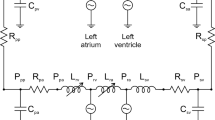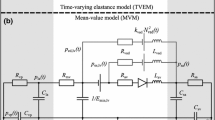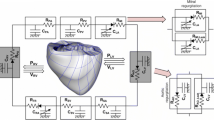Abstract
When a mechanical model of the rat aortic input impedance is perfused with a pulsatile pump, the computed values of the impedance components vary linearly with flow rate and are interactive. When the model is perfused by an isolated rat heart, the total load upon the left ventricle consists of the model and coronary impedances in parallel. Adenosine triphosphate induces changes in coronary impedance, and the redistribution of cardiac output from the model to the coronary circulation causes flow-related changes in the model impedance. Thus, the mechanical model does not provide a constant load for the isolated heart, because of variations in both the model and coronary impedances.
Similar content being viewed by others
References
Elzinga, G., andWesterhof, N. (1973): ‘Pressure and flow generated by the left ventricle against different impedances’,Circulation Res.,32, pp. 178–186
Home Office (1986): ‘Guidance on the operation of the animals (scientific procedures) act 1986’. (Her Majesty's Stationery Office, London)
Kouwenhoven, H. J., Vergroesen, I., Han, Y., andSpaan, J. A. E. (1992): ‘Retrograde coronary flow is limited by time-varying elastance’,Am. J. Physiol.,263, pp. H484-H490
McDonald, D. A. (1974): ‘Blood flow in arteries’ (Edward Arnold, London)
Milnor, W. R. (1982): ‘Hemodynamics’ (Williams & Wilkins, Baltimore)
Neely, J. R., Liebermeister, H., Battersby, E. J., andMorgan, H. E. (1967): ‘Effect of pressure development on oxygen consumption by isolated rat heart’,Am. J. Physiol.,212, pp. 804–814
Noordergraaf, A. (1978): ‘Circulatory system dynamics’ (Academic Press, New York
Spaan, J. A. E. (1995): ‘Mechanical determinants of myocardial perfusion’,Basic Res. Cardiol.,90, pp. 89–102
Westerhof, N., Elzinga, G., andSipkema, P. (1971): ‘An artificial arterial system for pumping hearts’,J. Appl. Physiol.,31, pp. 776–781
Wright, G., Sum Ping, J. T. S., Campbell, C. S., andTobias, M. A. (1988): ‘Computation of haemodynamic power and input impedance in the ascending aorta of patients undergoing open heart surgery’,Cardiovasc. Res.,22, pp. 179–184
Wright, G. (1988): ‘The hydraulic power outputs of pulsatile and nonpulsatile cardiopulmonary bypass pumps’,Perfusion,3, pp. 251–262
Wright, G. (1989): ‘Factors affecting the pulsatile hydraulic performance of the Stockert roller pump’,Perfusion,4, pp. 187–195
Wright, G. (1991): ‘Effects of vasoactive drugs upon haemodynamic power and input impedance in normal rats’,Cardiovasc. Res.,25, pp. 923–929
Wright, G. (1992): ‘Engineering and physiological approaches to the study of cardiovascular function: science and pseudoscience?’,Cardiovasc. Res.,26, pp. 215–217
Wright, G. (1994): ‘Hemodynamic analysis could resolve the pulsatile blood flow controversy’,Ann. Thorac. Surg.,58, pp. 1199–1204
Wright, G. (1995): ‘The assessment of pulsatile blood flow’,Perfusion,10, pp. 135–140
Author information
Authors and Affiliations
Corresponding author
Rights and permissions
About this article
Cite this article
Wright, G., Korchazhkina, O.V. & Zhang, S. Evaluation of a lumped parameter model for isolated working rat hearts. Med. Biol. Eng. Comput. 37, 190–195 (1999). https://doi.org/10.1007/BF02513286
Received:
Accepted:
Issue Date:
DOI: https://doi.org/10.1007/BF02513286




